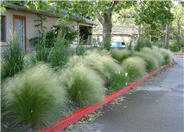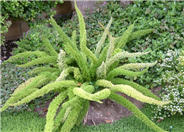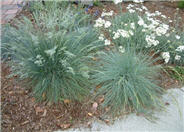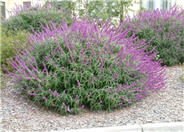
Common name:Mexican Feather Grass
Botanical name:Nassella tenuissima
This ornamental grass grows to 2' tall. It goes partially dormant during the summer but green in spring and fall. It prefers a sunny, well drained site. This plant can be invasive in some areas, so use caution. To keep reseeding to a minimum, drip irrigation will be best. Cut back in early spring to remove dormant foliage and dried seed heads. It can also tolerate dry shade. It grows to 10" wide and is the finest textured of the ornamental grasses.

Common name:Myers Asparagus
Botanical name:Asparagus densiflorus 'Myers'
An evergreen groundcover, the 'Myers' also makes an excellent hanging basket plant when larger in size. Its formal looking fronds have an even, spiral arrangement of leaflets. It is damaged by severe frosts, and looks best with at least occasional watering. Best planted in containers.

Common name:Blue Fescue
Botanical name:Festuca glauca
This ground cover/grass will grow less than 1' tall and has small, blue green leaves.

Common name:Kangaroo Paws, Red
Botanical name:Anigozanthos hybrids
This tender perennial is a clump-forming evergreen that produces fuzzy, yellow green flowers that bloom in spring and last for over 2 months. Many sizes and varieties are available including yellow and pink flowers.

Common name:Mexican Bush Sage
Botanical name:Salvia leucantha
The Mexican Sage is a bushy shrub that grows 3'-4' tall and wide. It has hairy white stems, gray green leaves and velvet-like purple flower spikes that bloom summer through fall. This shrub tolerates sun, light shade, little water, and is hardy to 15 degrees F. The Mexican Sage is drought tolerant and attracts hummingbirds.

Common name:Olive
Botanical name:Olea europaea
This broad tree will grow to 40' tall and has small, gray green leaves with fleshy black fruit that appears in fall. Purchase fruitless varieties to avoid the mess.
| Designer: The Plant Nerd | Come Sit for a While |
Photographer: GardenSoft |
Soils and Compost:
Practice grass-cycling by leaving short grass clippings on lawns after mowing, so that nutrients and organic matter are returned to the soil.
Water Saving Tip:
Lawn watering more than 5 minutes usually results in runoff. Use multiple cycle starts.
Integrated Pest Management:
Remove irrigation water and fertilizer from areas where you don't want weeds to grow.
